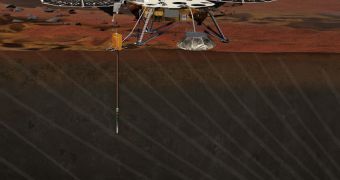According to an announcement made by experts at the NASA Jet Propulsion Laboratory (JPL), in Pasadena, California, a Mars exploration mission previously called GEMS is now called InSight.
The former GEophysical Monitoring Station has now been dubbed the Interior Exploration using Seismic Investigations, Geodesy and Heat Transport (InSight) mission. The change was done at the request of NASA.
The American space agency wants to reserve the name GEMS for the Gravity and Extreme Magnetism Small Explorer, an astrophysics mission that was already under development at the time the Martian lander was proposed.
InSight is a collaborative, international effort. In addition to JPL and several other NASA centers, it also includes the German Aerospace Center (DLR), the French Space Agency (CNES) and the Lockheed Martin Space Systems corporation.
Its purpose is to study the Martian underground, placing special emphasis on determining how terrestrial planets (such as Mars, Earth, Venus and Mercury) formed in the early solar system.
The Discovery mission concept calls for the deployment of a lander that would study the deep interior of the Red Planet, in an attempt to find out more about how it was put together. Despite years of study, there are still many things scientists don't know about why the solar system looks the way it does now.
“We chose the name InSight because we would literally peer into the interior of Mars to map out its structure,” explains the principal investigator of the mission, JPL research scientist Bruce Banerdt.
“With our geophysical instruments we will be able to see right through to the center of Mars, and will be able to map out how deeply the crust extends as well as the size of the core,” he goes on to say.
At this point, no one is sure whether InSight will actually be built and deployed. The proposal is part of a larger contest, featuring two other potential missions. NASA needs to make a decision on which of them to pursue on March 19, after analyzing the three concept studies.
The primary instrument on the proposed lander will be the Heat Flow and Physical Properties Package, also known as HP Cube or HP3. It will contain temperature sensors, and will be outfitted with drill bits capable of digging in up to 5 meters (16 feet) below the Martian surface.
“HP3 will give us new insights into the thermal development of Mars, and to water reserves that could be concealed beneath its surface,” explains the head of the DLR Institute of Planetary Research in Berlin-Adlershof, Germany, and the HP3 science leader, Tilman Spohn.
“This experiment has been carefully planned, and its outcomes could drive Mars research significantly forward. DLR is proud at the fact that its HP3 experiment is one of the successful mission proposals and could be a part of the next NASA Discovery mission,” the official concludes.

 14 DAY TRIAL //
14 DAY TRIAL //